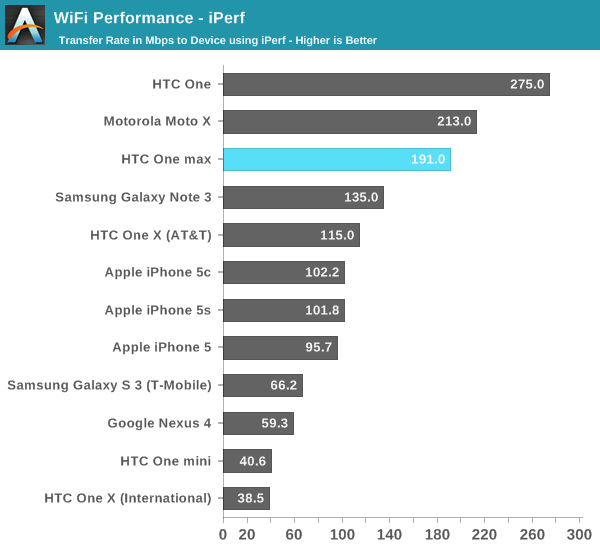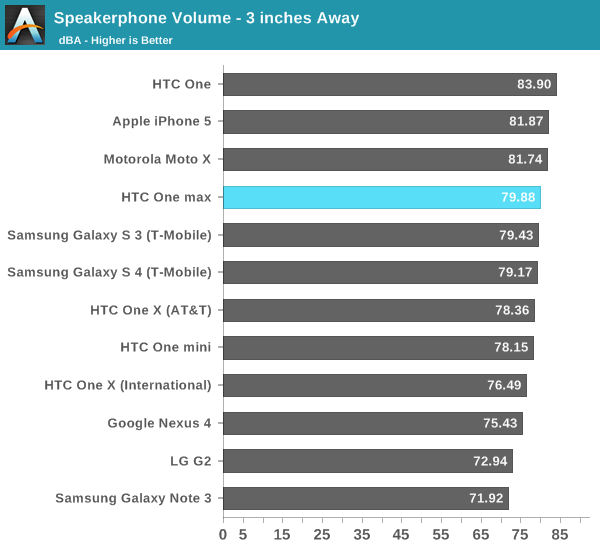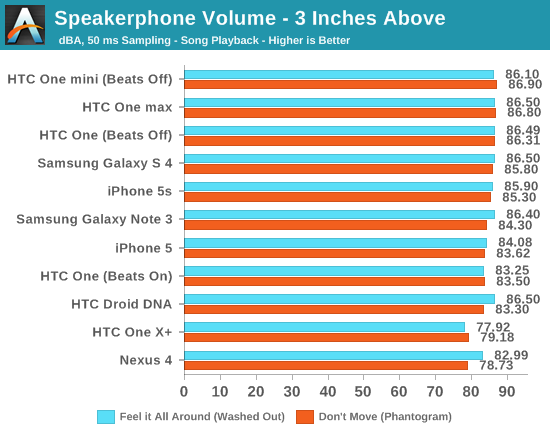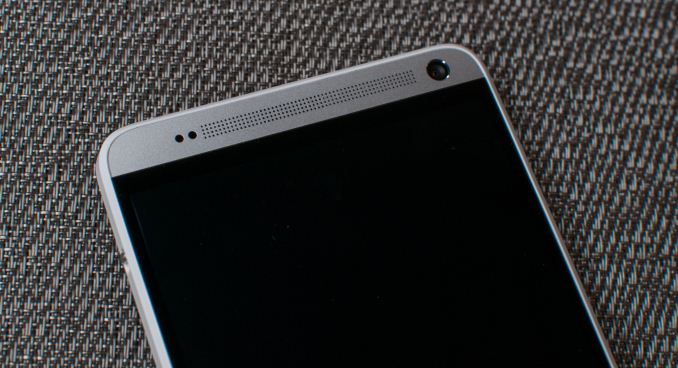HTC One max Review - It's Huge
by Brian Klug on October 28, 2013 10:00 AM EST- Posted in
- Smartphones
- HTC
- Mobile
- One
- Snapdragon 600
- Android 4.3
- One max
Cellular
Cellular on the One max is pretty much the same story as the One, and another shared bullet point. The top and bottom metal cutouts are still the radiative surfaces of the antenna, and there’s still transmit and receive diversity as well to mitigate any unwarranted antenna detuning from holding the device. The unit I was sampled has LTE banding for EMEA (Europe, Middle East, and Africa), but there’s appropriate banding for Asia, Sprint (a tri-mode device with 800/1900 MHz and TDD-LTE on 2600 MHz) and Verizon (700 MHz and AWS), according to the HTC specs page.
The baseband inside the One max is again shared with the One (Qualcomm’s 2nd generation multimode LTE MDM9x15 family), although the One max does have a bit more band support for the USA LTE on Sprint and Verizon, so the front ends are different.
WiFi
Interestingly enough with the One max we see HTC going to Qualcomm Atheros for the WLAN and BT combo, best I can tell this is the WCN3680 which is probably a bit cheaper to include than the BCM4335 we saw in the One. It’s still a single spatial stream 802.11ac capable part, meaning a PHY rate of up to 433 Mbps if you’re in the right channel conditions with 80 MHz channels on 5 GHz. The WCN3680 combo is the 802.11ac successor to WCN3660 which we saw in a number of phones last generation, and is accelerated by the SoC. WCN3680 also does BT 4.0, and FM Rx/Tx if applicable.

To test throughput on the One max I used iPerf the same way I have for a while now. Subjectively there are no complaints from me about WLAN connectivity on the One max, no random dropouts or issues, and Sense 5.5 thankfully still includes the WiFi frequency band manual selection option.
I saw the WCN3680 solution inside Moto X already, it’s interesting to see it in the One max. I believe the One mini uses its 802.11n cousin, WCN3660 as well, probably again for cost reasons.
Speakerphone
Although Beats is gone since that partnership has ended as of the One max, the device still seems to retain everything that made it sound great. There are still the larger-than-typical speaker chambers, big speaker grilles on the top and bottom, stereo sound, and importantly the TFA9887 speaker amplifier and protection part from NXP. In addition there’s still the TPA6185 headphone amplifier as well.
Beats always seemed to be an audio compressor that ran on the DSP, ostensibly through the Hexagon DSP access program or something, and that’s what’s absent on the One max. There’s no toggle under settings for enabling or disabling it, nor the Beats branding, but to be honest I almost always disabled Beats on the One anyways since it was a fair amount louder with it disabled. What made the One great was all the hardware behind the speakers, not so much the software compressor.


The One max goes plenty loud just like the original One. I went ahead and added the One mini and 5s to the chart too, just to check whether things have changed much, in addition to the Galaxy S 4 and Note 3. The One max basically performs like the One with Beats turned off, which isn’t a surprise since it isn’t there anymore. There’s also no detectable saturation, and the One line remains the only device that doesn’t sound tinny or rattly with overemphasized highs and lacking mids. I suspect the A weighting I selected a while ago for measuring might be a contributing factor as well. Either way you’re not going to be wanting for more loudness on the One max, and the inclusion of front firing stereo speakers makes for a completely different listening experience.












197 Comments
View All Comments
ddriver - Monday, October 28, 2013 - link
Doesn't seem to be doing well in its category (phablets that is) - considering devices already on the market and those soon to be launched, I'd guess the main selling point for this device will be brand loyalty. And people complained the note was too big...Omega215D - Tuesday, October 29, 2013 - link
The BoomSound speakers are much better than what the Note 3 puts out but you pay the price for them in extra height and possibly thickness. Also, HTC is pretty good at making the most of the battery capacity in which many of their phones have great standby times and good usage life.kmmatney - Tuesday, October 29, 2013 - link
The price may make a difference. I was planning on buying a note 3, but went for the LG Optimus Pro G because it was $200 cheaper at $99, and almost the same size screen. If the HTC One Max is $199, it might sway some buyers. I probably would have bought it just for the speakers.jshsimpson1 - Friday, November 15, 2013 - link
you missed out on the note 3Chaitanya - Monday, October 28, 2013 - link
a small typo on 1st page. Battery aint 1210mah, its 3300mah I believe.IanCutress - Monday, October 28, 2013 - link
1210 mAh is the Power Flip battery. 3300 mAh is the phone battery.MrCommunistGen - Monday, October 28, 2013 - link
If you're talking about this line: "The battery isn’t huge, at 1210 mAh and 3.75V (4.53 watt-hours), but it does give a boost as I’ll show in the battery section." he's referring to a battery + flip cover case.nerd1 - Monday, October 28, 2013 - link
One MAX - 164.5*82.5*10.29mm 217gGalaxy note 3 - 151.2*79.2*8.3mm 168g
I can understand the size but why that heavy and thick?
Johnmcl7 - Monday, October 28, 2013 - link
I was surprised at the thickness/weight as well, the larger Z Ultra comes in a lot thinner and a bit lighter despite the fact it has a larger 6.44in screen and fully weather sealed:Sony Z Ultra - 179.4 x 92.2 x 6.5 mm 212g
ShieTar - Monday, October 28, 2013 - link
Both the Note 3 and the Z Ultra are dead flat though, while the One Max has a nice curvature on the back. Its surely a question of personal reference which you prefer, personally I like the curved body better than something thin and flat.